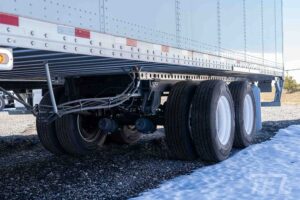SPONSORED BY TRUCKBASE
For asset-based carriers with 10 or more trucks, running an efficient dispatch operation is critical to winning and maintaining key customer relationships. Freight markets have become more competitive over the past few years, which in turn puts further pressure on carrier margins. Thus, the more you can leverage software and technology to scale and flex your team, the more leanly you can operate, and the more competitive you can afford to be.
Among the numerous options available, one software platform stands out for the 10 to 100 truck segment: Truckbase.
In this article, we’ll provide a deep dive into Truckbase’s solution as well as four trucking dispatch software alternatives you may want to consider, depending on your priorities, fleet size, and service offerings.
Truckbase: Pioneering the next wave of truck dispatch software
Truckbase (www.truckbase.com) solely serves asset-based carriers that tend to be in the 10 to 100 truck range. Unlike several competitors that try to serve carriers, shippers and brokers alike, Truckbase’s focus allows it to be both feature-rich and easy to learn, implement and use.
Founded in 2021 and built on modern, cloud-based technology, Truckbase offers a clean and intuitive user experience that simplifies the dispatch process, making it a favorite among dispatchers and drivers alike. Drivers appreciate that they do not need a separate app — the text-message-based dispatch functionality makes accepting a load as easy as a single click.
When it comes to user reviews, Truckbase holds the highest overall rating (an impressive 4.9 out of 5) among trucking dispatch software and carrier TMS alternatives on Capterra, the leading software reviews site in the US. In 2023, Truckbase won Capterra’s prized awards for Best Ease of Use, Most Recommended, Best Value, and Best Customer Support.
 Truckbase is designed to be the software that you and your team live in every day to run the business – from executive level profitability dashboards to driver settlements to truck tracking integrations with over 30 ELDs. Truckbase’s trucking dispatch suite is the core operational tool that growing carriers can rely on.
Truckbase is designed to be the software that you and your team live in every day to run the business – from executive level profitability dashboards to driver settlements to truck tracking integrations with over 30 ELDs. Truckbase’s trucking dispatch suite is the core operational tool that growing carriers can rely on.
An important driver of Truckbase’s success is its EDI capabilities, which enables fleets to connect directly to their most important customers. Many such customers are increasingly requiring this of carriers, thus making it table stakes to win and maintain profitable dedicated lanes.
Truckbase’s dedication to simplifying the dispatch process, combined with an easy-to-navigate interface and seamless integrations, positions it as the top choice for carriers aiming to enhance their efficiency and achieve significant growth in 2024 and beyond.
Truck Dispatch Providers: Four Alternatives to Consider
1. TMW Suite: A legacy solution for the largest fleets
TMW Suite by Trimble is one of the oldest and largest players in the transportation management sector, particularly favored by large-scale carriers. Its solution is engineered for the needs of mega fleets, ranging from several hundred to thousands of trucks. Despite its comprehensive offerings, the platform’s traditional framework might not always deliver the intuitive navigability seen in more recent market entries. Moreover, the cost and learning curve are both considerably higher than more modern solutions.
2. AscendTMS: The cost-effective option for the smallest fleets
AscendTMS is commonly known as “The Free TMS.” It positions itself as a cost-effective option for emerging carriers mindful of their expenses. It has basic functionality to get started on a TMS, with limited capabilities for growing fleets that require more features in their software. As a result of being built inexpensively, it also lacks the product design intentionality of a solution like Truckbase, making it somewhat cumbersome for a basic option.
3. Axon Software: If you are not on QuickBooks and require built-in accounting
While the majority of carriers use QuickBooks Online or QuickBooks Desktop, some prefer a TMS with a fully integrated accounting suite. This is where Axon shines. If your finance and accounting team is game to learn a new system, Axon is a consideration worth looking into.
That said, most accounting professionals are fluent in QuickBooks — it is relatively inexpensive, robust and integrates with leading modern TMS solutions. Thus, a consideration for growing fleets is if it’s worth the time and effort to train on a new accounting solution, especially when the core suite (dispatch, driver pay, EDI integrations, truck tracking) lags behind competing solutions.
4. Google Sheets: A ubiquitous free tool to help you get started
If you operate just a few trucks and are looking for the easiest way to get started, we recommend Google Sheets. We have even seen fleets grow to 20+ trucks using Google Sheets or spreadsheets before they start to break and cause real issues for customers.
While it will lack text message alerts to drivers, with AI-powered load importers, truck tracking capabilities and integrated financial tools, it can prove to be a solid and easy place to start to get your dispatch operation off the ground.
Conclusion
There is a wide array of trucking dispatch software options available on the market, and your unique profile and needs should factor into your decision. If you have 500+ trucks, consider TMW or McLeod. If you want built-in accounting, consider Axon. And if you’re just getting started, Google Sheets is probably good enough.
Once you hit 10+ trucks and have (or want) more sophisticated customers with which you can win dedicated lanes and that require more of you and your team, a modern carrier-focused solution like Truckbase can change the game for you and help you scale to 100+ trucks with ease.
Trucking Dispatch Software FAQs
What is the best trucking dispatch software for a fleet of 10 to 100 trucks?
For fleets within the 10 to 100 truck range, Truckbase is highly recommended due to its focus on this segment, feature-rich offerings and ease of use. It provides a comprehensive carrier TMS that includes dispatch capabilities, driver settlements, and truck tracking integrations.
Why should I consider Truckbase over other trucking dispatch software options?
Truckbase is designed specifically for asset-based carriers with 10 to 100 trucks, offering a modern, cloud-based platform that is both intuitive and powerful. It excels in simplifying the dispatch process and has received high ratings for ease of use, customer support and overall value.
What are the main advantages of using Truckbase for dispatch operations?
Truckbase offers several advantages, including a clean and intuitive user experience, text-message-based dispatch functionality, high integration capabilities with over 30 ELDs, and robust EDI capabilities that allow fleets to connect directly with key customers.
How does Truckbase compare to legacy systems like TMW Suite?
While TMW Suite is a legacy system favored by larger fleets, it tends to be more complex and expensive with a steeper learning curve. In contrast, Truckbase is built on modern technology, making it easier to use and implement, especially for small to mid-sized fleets.
Can smaller fleets benefit from using Truckbase, or should they consider other options?
Smaller fleets can benefit significantly from using Truckbase, particularly if they are aiming to grow and attract more sophisticated customers. For very small fleets or those just starting out, options like Google Sheets or AscendTMS might be sufficient initially, but transitioning to Truckbase can provide more advanced features as they scale.
The Trucker News Staff produces engaging content for not only TheTrucker.com, but also The Trucker Newspaper, which has been serving the trucking industry for more than 30 years. With a focus on drivers, the Trucker News Staff aims to provide relevant, objective content pertaining to the trucking segment of the transportation industry. The Trucker News Staff is based in Little Rock, Arkansas.








